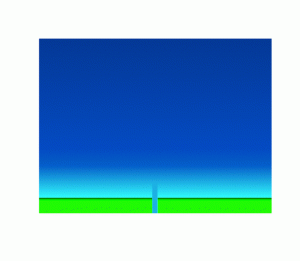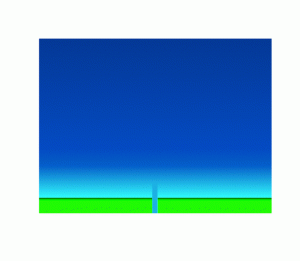When we think about how our landscapes evolve and change we probably tend to go straight for the big stuff, things like the climate, tectonics or geology, and in my previous blog I looked at how rainfall contributes to changing the planet’s surface. However, it is not just the big stuff which controls these changes, smaller things do as well, for example changes in land cover (ie, from grasses to trees, or the other way round) results in changes in the patterns of erosion and deposition, not just in the areas where the land cover changed but also further along a system.
There are also several examples of how animals can influence the processes driving landscape changes too. In Yellowstone Park, USA, the hydrological conditions in the area changed when the main predator, the grey wolf, disappeared from the area causing a knock-on effect on grazers removing sapling trees which in turn stops woodland reaching maturity resulting in a change in land cover. To try and reverse this the grey wolf was reintroduced but so far has not been successful returning the system to its former state. Recently it has been shown how spawning Pacific salmon can make localised changes to river channels and increase the ability of flows to erode the river, impacting the whole river profile.
But let’s get even smaller, right down to the smallest living things on Earth. Surely things like bacteria cannot influence how landscapes evolve over long periods of time? Well, think again. Serena Teasdale is an Early Career Researcher who works with me at the University of Hull, and she is researching how bacteria can change the erosion rates of shorelines.
“Often when we consider the role of biology, our initial assumption is that of vegetation. However, studies have begun to highlight the fundamental importance of EPS [technical way of saying slime, more on this later – Chris] on driving sediment behaviour, notably stabilising sediment and enhancing the erosion threshold. This occurs as the EPS matrix, secreted by microorganisms, forms bridging structures between sediment particles which prevent them from moving freely” she tells me.
Serena has developed a really neat demonstration to show the impact this slime can have on the resilience of sediment – she uses sandcastles. It’s simple but highly effective. One sandcastle is made using normal sand and a second has been mixed with xanthan gum, a proxy for this slime and it is commonly used as a binding agent in fat free mayonnaise. She pours water from a watering can over both and times how long it takes for them to fall apart – it is clear that the one full of slime takes much longer to collapse.
This slime is actually called Extracellular Polymeric Substances (EPS) and whilst this might sound like something made up for the Ghostbusters’ franchise it exerts huge influence over landforms. Physical experiments have shown that mixing sand and mud with different volumes of the xanthan gum proxy, and you only need a tiny amount, can shift river bed landforms from dunes, to ripples, to flat beds. It means our current models of interpreting past environments from buried bed forms might be wrong as these have not considered the effects of the bacterial slime.
The slime therefore can impact changes in sand castles and on river beds, but what about the evolution of landscapes? I spoke to another Early Career colleague, Josh Johnson, about his research –
“The extra stickiness causes deltas to form with fewer distributaries but these are larger and more stable.”
Comparisons of two deltas – both the same discharge but the right has low cohesion (stickiness) and the left high.
Josh has created an interactive display using animations of his modelling to show the impacts of river discharges and ‘stickiness’ on the developing shape and channel networks on deltas. In it you can choose low, medium and high levels of both and it shows you the result. Above we can see a low stickiness and high stickiness delta for medium discharges.
So next time you are out in the pristine landscape and considering just how it came to be, don’t just dwell on the big stuff, it might be all because of bacteria snot. Isn’t nature beautiful?



Pingback: Stratigraphy, Sedimentology and Palaeontology | Slimy Landscapes 2: This time it’s Precambrian